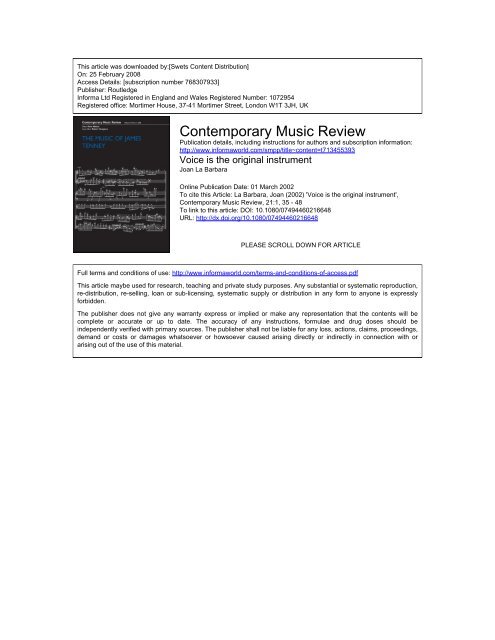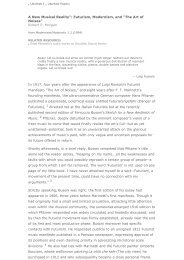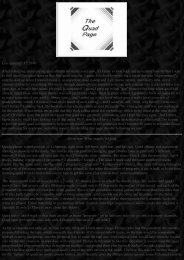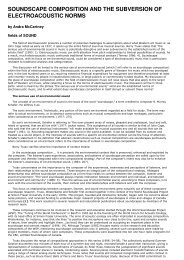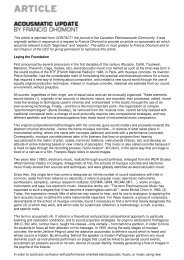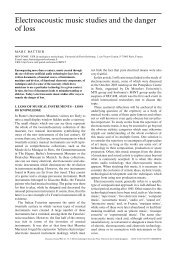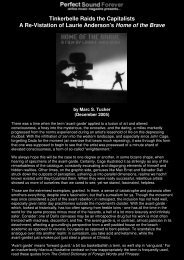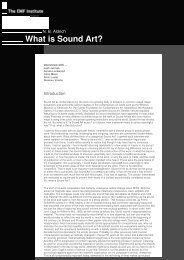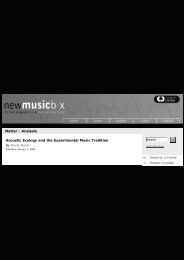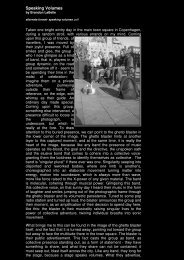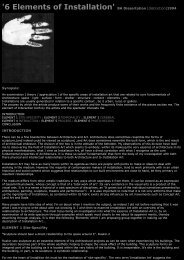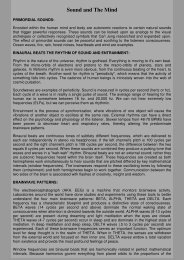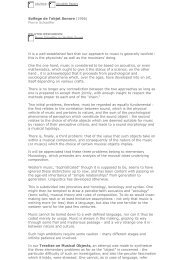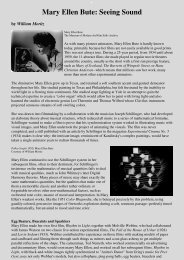La_Barbara-2002-Voice is the original instrument.pdf
La_Barbara-2002-Voice is the original instrument.pdf
La_Barbara-2002-Voice is the original instrument.pdf
You also want an ePaper? Increase the reach of your titles
YUMPU automatically turns print PDFs into web optimized ePapers that Google loves.
Vorwort=sçêïçêí=òìê=QK=^ìÑä~ÖÉ=iáÉÄÉ=iÉëÉêáååÉå=ìåÇ=iÉëÉêI=ÉêåÉìí=ÇΩêÑÉå=ïáê=fÜåÉå=ÉáåÉ=åÉìÉ=^ìÑä~ÖÉ=îçå=łdêìåÇâìêë=táêíëÅÜ~Ñíëã~íÜÉã~íáâ=éê®ëÉåíáÉêÉåK= få= ÇÉê= åìå= ëÅÜçå= QK= ^ìÑä~ÖÉ= Ü~ÄÉå= ïáê= ÇáÉ= ÄÉï®ÜêíÉ= hçåòÉéíáçå==ÄÉáÄÉÜ~äíÉåI= âäÉáåÉêÉ= cÉÜäÉê= âçêêáÖáÉêí= ìåÇ= ÉáåáÖÉ= ïáêíëÅÜ~Ñíëã~íÜÉã~íáëÅÜÉ= ^åJïÉåÇìåÖÉå= EòK= _K= òìê= léíáçåëÄÉïÉêíìåÖ= ìåÇ= báåâçããÉåëíÉìÉêÄÉêÉÅÜåìåÖF= ÉêJÖ®åòíK= ^ìÅÜ= ÇÉê= låäáåÉJpÉêîáÅÉ= òìã= _ìÅÜ= ïìêÇÉ= ÉêïÉáíÉêíK= pç= ïìêÇÉå= òK= _K= ÇáÉ=Ççêí=~åÖÉÄçíÉåÉå=bñÅÉäJqççäë=~ìëÖÉÄ~ìíK=wìÇÉã=ÄáÉíÉå=ïáê=açòÉåíÉå=ãáí=i~qÉñJbêÑ~ÜêìåÖ=åìå=~ìÅÜ=ÉáåÉ=~ìÑ=Ç~ë=_ìÅÜ=~ÄÖÉëíáããíÉ=sçêäÉëìåÖëéê®ëÉåí~íáçåK=táê= ïΩåëÅÜÉå= fÜåÉå= ïÉáíÉêÜáå= îáÉä= bêÑçäÖ= ÄÉá= ÇÉê= ^êÄÉáí= ãáí= ÇÉã= iÉÜêÄìÅÜ= ìåÇ=ÇÉå= çåäáåÉ= ìåíÉê= ïïïKïáã~J~ìÉêJëÉáíòKÇÉ= òìê= sÉêÑΩÖìåÖ= ëíÉÜÉåÇÉå= j~íÉêá~äáÉå=ìåÇ=Ç~åâÉå=eÉêêå=oçÄÉêí=sáåòÉäÄÉêÖ=ÑΩê=Éáå=~ÄëÅÜäáÉ≈ÉåÇÉë=hçêêÉâíìêäÉëÉåK=tÉáÇÉå=áK=ÇK=lmÑK=ìåÇ=iÉáéòáÖI==j~á=OMNP= == mêçÑK=aêK=cê~åò=pÉáíò== aêK=_Éåà~ãáå=oK=^ìÉê==sçêïçêí=òìê=PK=^ìÑä~ÖÉ=iáÉÄÉ=iÉëÉêáååÉå=ìåÇ=iÉëÉêI=ïáê= ÑêÉìÉå= ìåëI= fÜåÉå= ÜáÉêãáí= ÇáÉ= PK= ^ìÑä~ÖÉ= îçå= łdêìåÇâìêë= táêíëÅÜ~Ñíëã~íÜÉJã~íáâ=éê®ëÉåíáÉêÉå=òì=ÇΩêÑÉåK=^ìÑÖêìåÇ=ò~ÜäêÉáÅÜÉê=oΩÅâãÉäÇìåÖÉå=~ìë=ÇÉê=iÉëÉêJëÅÜ~ÑíI=áå=ÇÉåÉå=ÄÉíçåí=ïáêÇI=Ç~ëë=ÇáÉ=ÉáåÑ~ÅÜÉ=ìåÇ=îÉêëí®åÇäáÅÜÉ=a~êëíÉääìåÖ=ÇÉë=qÜÉãÉåÖÉÄáÉíÉë=ÇÉê=táêíëÅÜ~Ñíëã~íÜÉã~íáâ=ìåÇ=ÇáÉ=îáÉäÉå=_ÉáëéáÉäÉ=ìåÇ=§ÄìåÖëJ~ìÑÖ~ÄÉå=ãáí=âçãéäÉííÉå=i∏ëìåÖÉå=Eáã=_ìÅÜ=ìåÇ=áã=låäáåÉJpÉêîáÅÉF=ïÉëÉåíäáÅÜÉ=pí®êâÉå=ÇÉë=_ìÅÜÉë=Ç~êëíÉääÉåI=Ü~ÄÉå=ïáê=ÄÉá=ÇÉê=kÉì~ìÑä~ÖÉ=ÇáÉ=dêìåÇâçåòÉéíáçå=ÄÉáÄÉÜ~äíÉå= ìåÇ= ìåë= áã= tÉëÉåíäáÅÜÉå= ~ìÑ= ÉáåÉ= hçêêÉâíìê= ÇÉê= cÉÜäÉê= ìåÇ= âäÉáåÉ==bêÖ®åòìåÖÉå=áåÜ~äíäáÅÜÉê=^êí=ÄÉëÅÜê®åâíK=táê= ïΩåëÅÜÉå= fÜåÉå= ïÉáíÉêÜáå= îáÉä= bêÑçäÖ= ÄÉá= ÇÉê= ^êÄÉáí= ãáí= ÇÉã= iÉÜêÄìÅÜ= ìåÇ=ÇÉå= çåäáåÉ= ìåíÉê= ïïïKïáã~J~ìÉêJëÉáíòKÇÉ= òìê= sÉêÑΩÖìåÖ= ëíÉÜÉåÇÉå= j~íÉêá~äáÉå=ìåÇ=Ç~åâÉå=~å=ÇáÉëÉê=píÉääÉ=aáéäKJtáêíëÅÜKJj~íÜK=j~êíáå=pÅÜìëíÉê=ìåÇ=píÉÑÑÉå=_ìêâJÜ~êí=ÑΩê=Éáå=~ÄëÅÜäáÉ≈ÉåÇÉë=hçêêÉâíìêäÉëÉå=ìåÇ=JêÉÅÜåÉå=ëçïáÉ=ïÉêíîçääÉ=eáåïÉáëÉ=ìåÇ=sÉêÄÉëëÉêìåÖëîçêëÅÜä®ÖÉK=tÉáÇÉå=áK=ÇK=lmÑK=ìåÇ=iÉáéòáÖI==gìäá=OMNN= == mêçÑK=aêK=cê~åò=pÉáíò== aáéäKJ_ÉíêáÉÄëïK=EceF=_Éåà~ãáå=oK=^ìÉê==
c:/3cmr/21-1/030.3d ±5/6/2 ± 21:49 ± t&f/mpDownloaded By: [Swets Content D<strong>is</strong>tribution] At: 17:37 25 February 2008Contemporary Music Review, <strong>2002</strong>, Vol. 21, No. 1, 35±48<strong>Voice</strong> <strong>is</strong> <strong>the</strong> Original InstrumentJoan <strong>La</strong> <strong>Barbara</strong>The singer Joan <strong>La</strong> <strong>Barbara</strong>'s career as a composer, performer, and sound art<strong>is</strong>t has been devoted toexploring <strong>the</strong> human voice as a multifaceted <strong>instrument</strong>, going beyond its traditional boundaries tocreate works for voices, <strong>instrument</strong>s, and interactive technologies. As a pioneer in <strong>the</strong> ®eld ofcontemporary classical music and sound art, she has developed a unique vocabulary of experimentaland extended vocal techniques, including <strong>the</strong> multiphonics, circular singing, ululation, and glottalclicks that have become her signature sounds. Tracing her development as a performer and composer,<strong>La</strong> <strong>Barbara</strong> d<strong>is</strong>cusses her collaborations with American composers including John Cage, MortonFeldman, Alvin Lucier, Morton Subotnick, Philip Glass, and Steve Reich, and describes <strong>the</strong> musicalworld of New York in <strong>the</strong> 1970s.KEYWORDS:technologyNew York school, extended techniques, vocal music, minimal<strong>is</strong>m, performance art,I was always singing; I can't remember a time when I was not singing. Mymo<strong>the</strong>r says I told her when I was two years old that I was going to become asinger. We know a great deal when we are children; it takes a lifetime to becomewhat we know.I sang in church choirs as a child and was always given <strong>the</strong> solo parts <strong>the</strong>re andin school productions. In fact, I remember one Chr<strong>is</strong>tmastime when I had beengiven a solo part and <strong>the</strong>n came down with an illness. The director gave <strong>the</strong> soloto ano<strong>the</strong>r child. I was so furious, I managed to get well and return in time to sing<strong>the</strong> solo part in <strong>the</strong> production. I also played piano from <strong>the</strong> age of four. In highschool, I had a folk music group, The Calicos, four women. We sang incoffeehouses around <strong>the</strong> Philadelphia and New Hope (Pennsylvania) area.When I got to Syracuse University, I focused on <strong>the</strong> Western classical tradition,learning art songs and arias. There was a composer at Syracuse, Franklin Morr<strong>is</strong>,who was doing ``happenings'' and convinced <strong>the</strong> school to purchase a MOOGsyn<strong>the</strong>sizer. He didn't have an actual class in electronic music production ± th<strong>is</strong>was 1967 ± but allowed a few of us who were interested to come up to h<strong>is</strong> studioin <strong>the</strong> Crouse College tower and work on <strong>the</strong> equipment. I produced a couple ofpieces on tape and became fascinated with th<strong>is</strong> medium and with <strong>the</strong> explorationof sound in general. I had also become friends with Phyll<strong>is</strong> Bryn-Julson, who haddone extensive work with Gun<strong>the</strong>r Schuller, and she helped me convince HelenBoatwright to take me on as a student. Helen was renowned as a Bach sopranobut also had premiered Das Marienleben by Paul Hindemith. She taught me aContemporary Music ReviewISSN 0749-4467 print/ISSN 1477-2256 online # <strong>2002</strong> Taylor & Franc<strong>is</strong> Ltdhttp://www.tandf.co.uk/journalsDOI:07494460110095910
c:/3cmr/21-1/030.3d ±5/6/2 ± 21:49 ± t&f/mpDownloaded By: [Swets Content D<strong>is</strong>tribution] At: 17:37 25 February 200836 Joan <strong>La</strong> <strong>Barbara</strong>great deal about <strong>the</strong> performance persona and how to command <strong>the</strong> stage. I alsowas in Phyll<strong>is</strong> Curtin's summer master classes at Tanglewood/Berkshire MusicCenter for two summers and was exposed to a great deal of contemporary music<strong>the</strong>re. Curtin had, of course, worked with Ligeti, as well as doing conventionalopera, so I had two teachers who were combining contemporary with moretraditional music.The contemporary works I was singing at that time were fairly standard fare:Copland, Barber, Britten, Menotti, and Stravinsky. It wasn't until I came to NewYork ± anxious to get my career started and to be in a place where I could begin tomake career connections, I transferred from Syracuse after my junior year and®n<strong>is</strong>hed my degree at NYU in 1970 ± that I began to stretch out and experimentmore with my <strong>instrument</strong>. I studied with a teacher from Juilliard, Marian SzekelyFreschl, a statuesque Hungarian contralto in her seventies who used to tell me, ``Ivill just ®x your voice and <strong>the</strong>n I can die.'' She allowed me to sit in on <strong>the</strong> lessonsof her students at Juilliard and, whenever one would call in sick, she would givethat person's lesson to me. So I got to watch her teach many o<strong>the</strong>r students, aswell as getting additional lesson time for myself. I'd do my classes at NYU and<strong>the</strong>n get on <strong>the</strong> subway and rush up to Juilliard (which was at that time in <strong>the</strong> oldClaremont Avenue building that <strong>the</strong> Manhattan School of Music has since takenover), hungry to absorb as much information about <strong>the</strong> voice, mine or o<strong>the</strong>rs, as Icould. She arranged that I study breathing with a reg<strong>is</strong>tered nurse whose conceptand exerc<strong>is</strong>es were much like yoga.Freschl told me that it was important to sing contemporary music and that onemust become friends with composers and teach <strong>the</strong>m how to write for <strong>the</strong> voice.She had gone to school with BartoÂk and said he had helped her with her <strong>the</strong>oryexerc<strong>is</strong>es. Every summer, Freschl would return to Hungary, and, after <strong>the</strong> secondyear of my study with her, she had arranged that I attend Bor<strong>is</strong> Goldovsky'sopera workshop in West Virginia and study PelleÂas et MeÂl<strong>is</strong>ande. It was about thattime that I was becoming somewhat d<strong>is</strong>enchanted with <strong>the</strong> opera world and itsapproach to singing, learning to do roles as <strong>the</strong>y had been done for years,becoming part of <strong>the</strong> tradition. After Freschl left for Europe, I phoned <strong>the</strong> operaworkshop and told <strong>the</strong>m I was having vocal trouble and couldn't attend. Theytried to assure me that <strong>the</strong>y could ®x whatever problems I was having, but I told<strong>the</strong>m I just couldn't take <strong>the</strong> r<strong>is</strong>k. I walked away from <strong>the</strong> traditional singingworld at that moment and never turned back, although I do regret never havingshared my New Music world with Freschl.I began to work with jazz musicians, working with one <strong>instrument</strong> at a time,asking individual <strong>instrument</strong>al<strong>is</strong>ts to play long tones on single pitches as I triedto imitate that sound. It was a slow process: l<strong>is</strong>tening to <strong>the</strong> sound, analyzing <strong>the</strong>timbre, and <strong>the</strong>n sounding with <strong>the</strong> voice, analyzing again to judge how close Icame to that timbre, l<strong>is</strong>tening again and sounding again, gradually retraining mythinking as well as my voice. I also became fascinated with <strong>the</strong> ways <strong>instrument</strong>al<strong>is</strong>tswere extending <strong>the</strong>ir sounds, stretching <strong>the</strong> boundaries of what was <strong>the</strong>establ<strong>is</strong>hed technique. I didn't hear o<strong>the</strong>r singers doing that, and I wonderedwhy. I had heard recordings of Cathy Berberian, of course, and also l<strong>is</strong>tened tojazz scat singing. But I wanted to d<strong>is</strong>cover for myself what my voice could do, soI started improv<strong>is</strong>ing, alone and with o<strong>the</strong>r musicians. WBAI had somethingcalled <strong>the</strong> Free Music Store in <strong>the</strong> early seventies and, on Thursday nights, jazzand New Music musicians would ga<strong>the</strong>r for improv sessions. Anthony Braxton,
c:/3cmr/21-1/030.3d ±5/6/2 ± 21:49 ± t&f/mpDownloaded By: [Swets Content D<strong>is</strong>tribution] At: 17:37 25 February 2008<strong>Voice</strong> <strong>is</strong> <strong>the</strong> Original Instrument 37Frederic Rzewski, Garrett L<strong>is</strong>t, Steve <strong>La</strong>cy, I, and various o<strong>the</strong>rs would play forhours. On <strong>the</strong> evenings Rzewski was <strong>the</strong>re, he would always ins<strong>is</strong>t on having ad<strong>is</strong>cussion afterwards, analyzing what we had done and why. Although I foundit annoying at <strong>the</strong> time, it became part of <strong>the</strong> process, and I absorbed that instantanalys<strong>is</strong> into my thinking, so that it became as much a part of improv<strong>is</strong>ing as <strong>the</strong>making of sound. Th<strong>is</strong> marked <strong>the</strong> beginnings of my commitment to exploringnew sounds and ideas, and paved <strong>the</strong> way for my own compositional activitiesand for my connection as a performer to <strong>the</strong> creative thought processes of <strong>the</strong>composers with whom I would choose to work.In 1971, I was singing commercials for composer Michael Sahl, who alsoworked as Judy Collins's pian<strong>is</strong>t and music director. In one commercial for aJapanese perfume, I imitated everything from a koto (actually, a harp imitating akoto, since <strong>the</strong> ad executives thought <strong>the</strong> koto was too ethnic-sounding forAmerican l<strong>is</strong>teners) to eventually sounding something like a Japanese AstrudGilberto. Michael knew that Steve Reich was looking for singers who couldimitate <strong>instrument</strong>al sounds, and so I auditioned and started working with himon Drumming. At ®rst, he thought he wanted me to imitate <strong>the</strong> sound of bongodrums, but <strong>the</strong>n he decided that a male voice sounded better with <strong>the</strong> drums andthat <strong>the</strong> female voice worked better with marimba. It was just what I had beenworking on; h<strong>is</strong> needs and my technique were a perfect match. Steve would puttape loops on <strong>the</strong> decks, and, as <strong>the</strong> patterns shifted out of phase and into newinterlocking relationships, we (at ®rst with singer, now producer, Judy Sherman,later with jazz singer Jay Clayton) would improv<strong>is</strong>e, singing <strong>the</strong> resultingpatterns that we heard. Steve chose certain patterns and <strong>the</strong>n locked <strong>the</strong>m into<strong>the</strong> ®nal score. I worked with Steve for three years (1971±1974), through <strong>the</strong>Deutsche Gramophon recordings of Drumming and Music for Mallet Instruments,<strong>Voice</strong>s and Organ. We did most of our performances in European art galleries andmuseums where American new music was welcomed. When we came back toAmerica, with <strong>the</strong> exception of Town Hall, which Steve rented for <strong>the</strong> Drummingpremiere, our concerts were also predominantly in galleries and museums; <strong>the</strong>concert world was not yet ready for th<strong>is</strong> kind of music.Philip Glass came to one of <strong>the</strong> concerts, and I introduced myself to him andasked if he had ever considered using voice in h<strong>is</strong> music. He replied that YvonneRainer (a ®lmmaker and one of <strong>the</strong> Grand Union/Judson Church dancers) cameby every once in awhile and screamed along, but it wasn't exactly singing. Heasked if I knew h<strong>is</strong> music, and I said no, so he invited me to a concert he wasgiving later that week in a loft on <strong>La</strong>fayette Street, just off <strong>the</strong> Bowery. I went,climbed <strong>the</strong> ten ¯ights to a grungy loft space, and l<strong>is</strong>tened to th<strong>is</strong> loud, trancelikemusic played by ¯utes, saxophones, and Far®sa organs. I liked what I heard, toldhim so, and he said that h<strong>is</strong> trumpet player had just died, and I could join <strong>the</strong>band and sing <strong>the</strong> trumpet part if I wanted. Over <strong>the</strong> 3±4-year period I workedwith Glass, he produced <strong>the</strong> monumental six-hour Music in 12 Parts (which wepremiered at a gigantic event at Town Hall complete with a dinner break),Ano<strong>the</strong>r Look at Harmony, and Philip's ®rst foray into <strong>the</strong> potential area of popmusic, North Star. I gradually taught him more about what <strong>the</strong> voice could do,how long one could stay in a limited tessitura, and when one needed to move toano<strong>the</strong>r part of <strong>the</strong> range to avoid vocal fatigue. Philip was very supportive of mysolo concert work, encouraging me to do performances whenever possible onfree days while we were on tour. In <strong>the</strong> summer of 1976, we premiered Einstein on
c:/3cmr/21-1/030.3d ±5/6/2 ± 21:49 ± t&f/mpDownloaded By: [Swets Content D<strong>is</strong>tribution] At: 17:37 25 February 200838 Joan <strong>La</strong> <strong>Barbara</strong><strong>the</strong> Beach, <strong>the</strong> now-acknowledged landmark experimental opera, at <strong>the</strong> Festivald'Avignon.That same summer, I also premiered John Cage's Solo for <strong>Voice</strong> 45 from SongBooks with Atlas Ecliptical<strong>is</strong> for orchestra and Winter Music for two pianos at <strong>the</strong>Festival de <strong>La</strong> Rochelle. The two-hour-and-forty-minute performance was both atriumph and a d<strong>is</strong>aster. The orchestral players m<strong>is</strong>behaved, clowning, talking,drinking on-stage, and doing <strong>the</strong>ir utmost to d<strong>is</strong>rupt <strong>the</strong> proceedings, while <strong>the</strong>conductor Richard Dufallo, <strong>the</strong> two pian<strong>is</strong>ts, and I did our best to stay focusedand perform our musical tasks. At <strong>the</strong> end of <strong>the</strong> performance, Cage was lividabout <strong>the</strong> orchestra's behavior but was delighted with mine, prom<strong>is</strong>ing to be withme always from that moment on. He became my mentor, <strong>the</strong> one I trusted withmy professional and personal guidance. While we were at <strong>La</strong> Rochelle, I told himI was troubled about <strong>the</strong> Einstein production and that I felt it was taking a greatdeal of time, pulling me away from my own work. As we walked on <strong>the</strong> beach, Iasked Cage's advice about what I should do, and h<strong>is</strong> response was that hethought I had already come to a dec<strong>is</strong>ion. Guidance, not answers. I took animportant step toward establ<strong>is</strong>hing my independent identity, leaving <strong>the</strong> GlassEnsemble after <strong>the</strong> Einstein premiere to devote myself to o<strong>the</strong>r work and to myown compositional development.I had ®rst encountered John Cage in Berlin in 1972 at a performance ofHPSCHD at <strong>the</strong> Berlin Philharmonie. It had so infuriated me ± <strong>the</strong> cacophonyand <strong>the</strong> crowds and <strong>the</strong> moon landing slides and performers talking instead ofplaying ± that I marched up to him and demanded, ``With all <strong>the</strong> chaos in <strong>the</strong>world, why do you make more?'' The devotees seated at h<strong>is</strong> feet gasped, and Iturned on my heel and stormed off, certain I wouldn't get a reasonable reply inthat situation. Several minutes later, I felt a tap on my shoulder and turned to seeJohn smiling beati®cally. ``Perhaps when you go back out into <strong>the</strong> world, it won'tseem so chaotic.'' I was charmed and aston<strong>is</strong>hed that he had sought me out in <strong>the</strong>melee and produced a reasoned, thoughtful answer to my question. It changedmy mind about him and about music.In 1974, when I was about to do solo concerts of my own music for <strong>the</strong> ®rsttime, I saw Cage at a performance at Phill Niblock's loft (Cage was alwaysattending concerts when he wasn't performing in <strong>the</strong>m) and gave him a l<strong>is</strong>t of myupcoming events, saying, ``I'm doing some concerts, and I'd like you to be <strong>the</strong>re.''He went through some dif®culty to attend <strong>the</strong> ®rst of <strong>the</strong>se, arriving at <strong>the</strong> wrongvenue and <strong>the</strong>n rushing to ®nd <strong>the</strong> right one. I premiered my <strong>Voice</strong> Piece: One-Note Internal Resonance Investigation that evening, a rigorous eÂtude exploring <strong>the</strong>multitude of timbres, colors, overtones, and multiphonics that could be createdfrom a single tone. Cage loved it and my performance and asked me if I'd like towork with him. He gave me <strong>the</strong> score to Solo for <strong>Voice</strong> 45 from Song Books,eighteen pages of ``aggregates'' with numbers above each aggregate determininghow many pitches were to be chosen in <strong>the</strong> alto and treble clefs, and lettersbeneath, to be used as vocalize. It took me nearly six months to work out mydec<strong>is</strong>ions, notate <strong>the</strong>m, and learn to sing <strong>the</strong>m ``as fast as possible.'' When I felt Iwas ready, I phoned him and invited him to my loft to l<strong>is</strong>ten. He told me it wasbeautiful but it wasn't fast enough, and <strong>the</strong>n demonstrated how he wanted <strong>the</strong>sound to be a ¯urry of notes, like a calligraphic gesture. I worked harder atgetting my speed faster but complained to David Tudor that Cage's directionshadn't been clear. He looked at <strong>the</strong>m and said that Cage had been clear; I simply
c:/3cmr/21-1/030.3d ±5/6/2 ± 21:49 ± t&f/mpDownloaded By: [Swets Content D<strong>is</strong>tribution] At: 17:37 25 February 2008<strong>Voice</strong> <strong>is</strong> <strong>the</strong> Original Instrument 39hadn't taken <strong>the</strong>m literally enough. Ano<strong>the</strong>r lesson. Over <strong>the</strong> years as I workedwith Cage, I watched him answer many questions about h<strong>is</strong> music, respondingcarefully to questions even when people interrupted him during a meal, and healways referred back to <strong>the</strong> score or to <strong>the</strong> printed instructions, making certainthat <strong>the</strong> answer was <strong>the</strong>re. In cases of ambiguity, he would write in a correctionor clari®cation.Cage had spoken of me to Alvin Lucier. ``She has devoted her life tocontemporary music. Isn't that marvelous?'' Based on Cage's description andwithout having heard me sing, Alvin trusted me to work with him on a new piecehe was developing, Still and Moving Lines of Silence in Families of Hyperbolas. Wed<strong>is</strong>cussed <strong>the</strong> concept of interference patterns. Alvin explained how he wouldcreate a sonic geography of peaks and troughs, valleys of silence one could movethrough, bordered by walls of sound. We were rehearsing in <strong>the</strong> Cunninghamdancespace at Westbeth, and, as I moved onto <strong>the</strong> wooden ¯oor, I began singingvery softly, changing my pitch microtonally, causing <strong>the</strong> oscillator-producedsoundwaves from <strong>the</strong> speakers to beat against <strong>the</strong> vocal soundwaves, giving <strong>the</strong>impression that I could move <strong>the</strong>m away from me. After about twenty minutes, Istopped, and Alvin asked me what I had been doing. I explained that I waslocating myself in <strong>the</strong> sonic center of <strong>the</strong> room by ®nding <strong>the</strong> place where <strong>the</strong>sound waves were bombarding me equally from all sides, and I could push <strong>the</strong>maway from me by tuning my voice, adjusting <strong>the</strong> pitch to de¯ect <strong>the</strong> oscillatorwaves. Alvin was fascinated by my approach to <strong>the</strong> concept we had d<strong>is</strong>cussed. We®rst performed <strong>the</strong> work at <strong>the</strong> MuseÂe d'Art Moderne for <strong>the</strong> Festival d'AutomneaÁ Par<strong>is</strong> in 1974. I also performed <strong>the</strong>re for <strong>the</strong> ®rst time with two o<strong>the</strong>r members of<strong>the</strong> Sonic Arts Union, <strong>the</strong> quartet of kindred-thinking electronic-based composerswho had banded toge<strong>the</strong>r to produce concerts and share equipment on <strong>the</strong>ir tours.David Behrman had created a new work for me called <strong>Voice</strong> with Melody-drivenHarmonies for Merce Cunningham's dance, Rebus, in which speci®c pitches that Isang caused <strong>the</strong> oscillator tones to shift and slide about. I also played viola in a soloversion of Robert Ashley's work for string quartet, in which ticks from <strong>the</strong> bowpulled slowly across <strong>the</strong> string of <strong>the</strong> viola, placed in my lap, caused electronic``gates'' to open, allowing portions of Mimi Johnson's rambling storytelling to beheard, or not.In 1974, I began writing preview articles for <strong>the</strong> SoHo Weekly News, a free paperthat was given out on <strong>the</strong> streets of <strong>the</strong> burgeoning arts neighborhood. I felt thatmany of <strong>the</strong> composers I was working with were being m<strong>is</strong>understood by <strong>the</strong>critics and that, if I could provide insight in advance to both <strong>the</strong> audience and <strong>the</strong>critics, I would be providing a meaningful service. John Rockwell began quotingsome of my comments in h<strong>is</strong> New York Times reviews and suggested to me thatShirley Fleming was looking for someone to write about contemporary music inMusical America magazine. I contacted her and subsequently served as <strong>the</strong> NewMusic Editor for that monthly publication from 1977 to 1987, writing descriptivearticles that were designed to give readers a sense of what <strong>the</strong>y would haveexperienced had <strong>the</strong>y been at <strong>the</strong> performance. For many years, people told me<strong>the</strong>y depended on my articles to inform <strong>the</strong>m about <strong>the</strong> New Music scene in NewYork and at <strong>the</strong> various festivals I attended worldwide.Some of my works from <strong>the</strong> early seventies were strongly in¯uenced by <strong>the</strong>world of conceptual art and re¯ected <strong>the</strong> thinking and pondering and emphas<strong>is</strong>on process that was very much a part of <strong>the</strong> gallery and art performance scene.
c:/3cmr/21-1/030.3d ±5/6/2 ± 21:49 ± t&f/mpDownloaded By: [Swets Content D<strong>is</strong>tribution] At: 17:37 25 February 200840 Joan <strong>La</strong> <strong>Barbara</strong>Hear What IFeel (1974±1975) was a sensory deprivation performance piece,de®nitely conceptual art but also designed to help me d<strong>is</strong>cover new vocalsounds. I spent an hour before <strong>the</strong> performance in an <strong>is</strong>olated room with myeyes taped shut, also not touching anything. The idea was that if one or two ofone's usually functioning senses were cut off from normal response, o<strong>the</strong>rswould become more active, stronger in response to that deprivation of data. After<strong>the</strong> <strong>is</strong>olation period, I was led out to <strong>the</strong> performance space, eyes still taped shut.My ass<strong>is</strong>tant would have placed a variety of items in six glass d<strong>is</strong>hes (I stipulatedonly that nothing should crawl or injure me), and I tried to vocalize an immediatereaction to touching <strong>the</strong>se substances, not trying to identify but to respond tofeelings, emotions, to <strong>is</strong>sue a sonic response. I wanted to communicate with <strong>the</strong>audience on a pre-verbal sound level, while also revealing possible new vocalterritory.In 1974, I wrote Performance Piece, a work based on left brain/right brainthought patterns, exploring <strong>the</strong> art<strong>is</strong>tic process in real time, that <strong>is</strong>, vocalizingwhen I was thinking in sonic gestures and verbalizing when I found myselfanalyzing <strong>the</strong> sounds or making conscious dec<strong>is</strong>ions about how to order <strong>the</strong>m.The trigger or inspiration for th<strong>is</strong> work came from a d<strong>is</strong>cussion I had with RobertAshley during an interview for one of my SoHo Weekly News preview articles,regarding what he referred to as <strong>the</strong> ``internal dialogue'' that one has with oneself(self-monitoring or censoring one's own thoughts before speaking <strong>the</strong>m aloud). Isubtitled Performance Piece ``Ashley gave me an idea,'' because our conversationgot me thinking about how one makes conscious dec<strong>is</strong>ions during improv<strong>is</strong>ationbut <strong>the</strong> audience only hears <strong>the</strong> musical result, not <strong>the</strong> process of considering thatone goes through in making musical dec<strong>is</strong>ions. I thought th<strong>is</strong> would be afascinating exploration. In fact, both works proved intriguing both to me andto <strong>the</strong> audience but were also somewhat psychologically stressful for me in <strong>the</strong>irnecessity to expose an honest dialogue over <strong>the</strong> brain bridge.In 1975 and 1976, Morton Feldman, whom I had met several years earlier whileperforming at Walter Bachauer's Metamusik Festivals in Berlin, invited me to beV<strong>is</strong>iting Slee Composer at <strong>the</strong> Center for Creative and Performing Arts at SUNY-Buffalo. I had been exploring my vocal ideas in specialized eÂtudes andimprov<strong>is</strong>ational settings for several years, in solo concerts in New York andEurope, and with <strong>the</strong> New Wilderness Preservation Band, an improv<strong>is</strong>ationalensemble that provided musical soundscapes for various poets and writers inconcert-readings at Washington Square Church. Roger Reynolds had also heardof my experimental vocal work and had come to my loft to invite me to join anew Extended Vocal Techniques Ensemble at <strong>the</strong> Center for Music Experiment at<strong>the</strong> University of California in San Diego (UCSD). I was happy doing myexplorations as a solo art<strong>is</strong>t and wasn't sure I wanted to leave New York tojoin an ensemble, especially for <strong>the</strong> kind of money that was being offered. So Istayed in New York, traveling and performing solo concerts, and acceptedFeldman's offer to v<strong>is</strong>it Buffalo on a v<strong>is</strong>iting art<strong>is</strong>t bas<strong>is</strong>, allowing me to exploresome of my <strong>instrument</strong>al ideas with <strong>the</strong> Creative Associates, a select group ofspecial<strong>is</strong>ts in contemporary music.That season, I had been awarded my ®rst grant for music composition, fromCAPS (Creative Art<strong>is</strong>ts Pubic Service program), a div<strong>is</strong>ion of <strong>the</strong> New York StateCouncil for <strong>the</strong> Arts. I was exploring a new work for six timpani and voice withlive electronics, called Thunder. The electronics I was using at that time were
c:/3cmr/21-1/030.3d ±5/6/2 ± 21:49 ± t&f/mpDownloaded By: [Swets Content D<strong>is</strong>tribution] At: 17:37 25 February 2008<strong>Voice</strong> <strong>is</strong> <strong>the</strong> Original Instrument 41essentially designed for electric guitar players. I had started using <strong>the</strong>m on mywork Vocal Extensions (which I premiered in concert at Washington SquareChurch in New York on 17 January 1975) to extend <strong>the</strong> voice fur<strong>the</strong>r throughelectronic modi®cation and also to use <strong>the</strong> electronics as a surpr<strong>is</strong>e element,turning <strong>the</strong> dials randomly, and <strong>the</strong>n playing with <strong>the</strong> resulting sounds as Iwould play with sounds coming from o<strong>the</strong>r musicians in an ensemble setting. Ipremiered Thunder at The Kitchen in 1976, along with ano<strong>the</strong>r ensemble work,Ides of March for string and vocal quartets and percussion, exploring <strong>the</strong> acousticphenomenon of ``beats'' occurring between closely tuned <strong>instrument</strong>s, using <strong>the</strong>percussion to articulate, punctuate, and reinforce <strong>the</strong> naturally occurring beatpatterns. I was looking forward to exploring <strong>the</strong>se works with o<strong>the</strong>r musicians,such as <strong>the</strong> Creative Associates at Buffalo. Feldman was very encouraging andsupportive of my music.In 1977, I was invited by Hans Otte, Director of New Music, to do a productionfor Radio Bremen in Germany. It was <strong>the</strong> ®rst of my ``sound paintings,'' multitrackvocal works composed for tape utilizing my extended vocal techniques asan orchestra of voices. My concept was v<strong>is</strong>ual as well as sonic: I felt as if I werepainting on <strong>the</strong> tape with my voice, making vocal gestures and layering <strong>the</strong>se tocreate a textured, multi-layered composition. The work was called Twelvesongand utilized 12 tracks of voice in a composition that lasted 12 minutes and 12seconds. I began by recording <strong>the</strong> ``foundation'' tracks, steady tones, circularlysung on inhale and exhale to create a constant sound, micro-tonally separatedfrom each o<strong>the</strong>r to create subtle beats. Over <strong>the</strong>se tracks, I layered ¯utters(ululation), inhaled glottal clicks, gentle sighing gl<strong>is</strong>sandi, and birdlike sounds.I'm quite certain <strong>the</strong> recording engineers had never experienced th<strong>is</strong> kind of realtimecomposition or such unusual vocal sounds, but <strong>the</strong>y were very professionaland supportive, and Hans Otte was delighted with <strong>the</strong> result. I learned a greatdeal about mixing from that session, recorded in one day and mixed thatevening. Once I had sung all of my material, it was time to place it in <strong>the</strong>stereo horizon, and that was where <strong>the</strong> engineers took over and taught me about®nding a unique spot for each sound so that each sound was d<strong>is</strong>tinct but blendedinto a cohesive fabric.In September 1976, I traveled with Cage to Los Angeles to do performances at<strong>the</strong> California Institute of <strong>the</strong> Arts. I performed a version of Solo for <strong>Voice</strong> 45 fromSong Books with twenty pian<strong>is</strong>ts playing Winter Music on <strong>instrument</strong>s placed ontwo levels of <strong>the</strong> Main Gallery space. It was a very successful performance in amarvelous contemporary music festival that also featured works by Feldman,and that was <strong>the</strong> beginning of my association with Cal Arts. In 1978, MortonSubotnick invited me to be guest composer <strong>the</strong>re, replacing him while he wastouring. I was delighted to have <strong>the</strong> opportunity to be at a place that encouragedinterd<strong>is</strong>ciplinary work, and I also looked forward to being able to explore some ofmy ideas for multitracked voices with electronic modi®cations and spatiallocation.I composed and recorded a work <strong>the</strong>re, Autumn Signal, using <strong>the</strong> Buchlasyn<strong>the</strong>sizer to alter some of my vocal sounds and also for spatial movement ofthose sounds. It was <strong>the</strong> ®rst of my ``soundances,'' a continuation of <strong>the</strong> idea ofsound painting but now fur<strong>the</strong>r personifying <strong>the</strong> sounds as ®gures, sonic dancersin space. I had had an opportunity to work with Merce Cunningham's DanceCompany on several occasions, both in my own music for an ``Events'' evening
c:/3cmr/21-1/030.3d ±5/6/2 ± 21:49 ± t&f/mpDownloaded By: [Swets Content D<strong>is</strong>tribution] At: 17:37 25 February 200842 Joan <strong>La</strong> <strong>Barbara</strong>and also with o<strong>the</strong>r composers. For <strong>the</strong> ``Events,'' Merce gave <strong>the</strong> composer atimeframe to work within, and he chose which dances or sections of danceswould be done in <strong>the</strong> same time frame. I chose Thunder as one of my works toperform and, afterwards, <strong>the</strong> dancers told me it had been an incredibleexperience for <strong>the</strong>m because <strong>the</strong> dance <strong>the</strong>y were doing, Summerspace, had<strong>original</strong>ly had a score by Morton Feldman! It transformed <strong>the</strong>ir imaginaryspace from some place gentle and serene into a kind of jungle atmosphere. Ialso chose to do my rigorous eÂtude Circular Song (1975) that evening and, in oneof those strange coincidences, as I started my solo work, Merce moved onstage todo a solo dance. It was a uniquely extraordinary experience for me as youngcomposer. I was fascinated with what I saw as Merce's concept of individualsimultaneous movements, that groups of dancers or individuals could be doingvery different kinds of movements at <strong>the</strong> same time but that a complex yetcohesive whole was achieved. I wanted to try to achieve that idea with sounds, togive each sound a kind of trajectory through space, moving like individualdancers, but contributing to a cohesive sonic whole. I premiered my workAutumn Signal in West Berlin at Metamusik Festival 1978.<strong>La</strong>te in 1978, I was awarded an art<strong>is</strong>t-in-residency by <strong>the</strong> DAAD (DeutscherAkadem<strong>is</strong>cher Austauschdienst KuÈ nstlerprogramm) to live and work in WestBerlin for <strong>the</strong> calendar year 1979. I arrived in January to gray skies and constantsnow, a good time and place to stay inside and work. I decided to rent a pianoand compose a performance work for solo pian<strong>is</strong>t, collecting objects from around<strong>the</strong> apartment to use inside <strong>the</strong> piano. I found a small wooden ball which I triedbouncing on <strong>the</strong> strings, chopsticks (which I later switched to felt-coveredwooden dulcimer hammers), some oddly shaped paper clips to attach to <strong>the</strong>strings, creating bell-like or gong-like sounds depending on where I placed <strong>the</strong>m.I recorded vocal sounds and played <strong>the</strong>se back through small speakers placedinside <strong>the</strong> piano, so that <strong>the</strong> piano and <strong>the</strong> pian<strong>is</strong>t were carrying on a dialogue. Ihad been a pian<strong>is</strong>t in my youth, and so Responsive Resonance (with Fea<strong>the</strong>rs)explored memories as well as <strong>the</strong> psychological state of <strong>the</strong> solitary art<strong>is</strong>tintimately involved with <strong>the</strong> <strong>instrument</strong>, with <strong>the</strong> tools of <strong>the</strong> craft and engagedin <strong>the</strong> means of expression. The work was premiered by composer-pian<strong>is</strong>t JoanTower at Chr<strong>is</strong>t and St Stephen's Church in Manhattan, 21 May 1979.The DAAD residency afforded me time to compose quite a number of works. Icreated a new score, Twelve for Five in Eight, based on my sound painting,Twelvesong, translating my multitrack tape work into a ®ve-voice graphic andtraditionally notated score for performance by myself with <strong>the</strong> Extended VocalTechniques Ensemble of San Diego. We performed it at contemporary musicfestivals at Cal Arts and at UCSD. Also, I composed two new works for radio,Klee Alee and ShadowSong, produced at <strong>the</strong> RIAS studios in Berlin. Both weresound paintings but were very different in character. Klee Alee was inspired by apainting I had seen in <strong>the</strong> Walraf Richartz (now Ludwig) Museum in KoÈln. Imade extensive notes about <strong>the</strong> colors and structure and thickness of <strong>the</strong> paintand <strong>the</strong> ®gures scratched into it by <strong>the</strong> art<strong>is</strong>t Paul Klee. What I neglected to notewas <strong>the</strong> name of <strong>the</strong> painting. Subsequently, I have looked in books ofreproductions and am almost certain that <strong>the</strong> work that inspired Klee Alee wasHauptweg und Nebenweg, although that painting was one of a series of grid-likeworks. I constructed sound blocks of particular timbres which re¯ected for me<strong>the</strong> greens and blues of <strong>the</strong> painting. I <strong>the</strong>n ``scratched'' into <strong>the</strong> thickness of <strong>the</strong>
c:/3cmr/21-1/030.3d ±5/6/2 ± 21:49 ± t&f/mpDownloaded By: [Swets Content D<strong>is</strong>tribution] At: 17:37 25 February 2008<strong>Voice</strong> <strong>is</strong> <strong>the</strong> Original Instrument 43vocal sound blocks as Klee had scratched into <strong>the</strong> thickness of h<strong>is</strong> paint, creatingtiny ®gures using inhaled sounds, some thin, some click-like, some pensive, somewailing and d<strong>is</strong>tressed. ShadowSong explored, again, a psychological state ± inth<strong>is</strong> case, <strong>the</strong> idea that as one moves through <strong>the</strong> day, or through life, oneencounters d<strong>is</strong>tractions, images on <strong>the</strong> periphery of sight or thought. Oneconstantly has to choose to continue with one's chosen path, or to diverge andmove into <strong>the</strong> realm controlled by <strong>the</strong> ``d<strong>is</strong>tractions,'' a kind of ``road not taken''exploration, with language playing a subtle part. Words for ghosts, spectres,shadows in several languages, drift into audibility and melt away again. Shadow-Song and Klee Alee were premiered at Festival d'Automne aÁ Par<strong>is</strong> in September1979.During <strong>the</strong> Berlin residency, I also produced, with ¯ut<strong>is</strong>t Eberhard Blum, afour-day festival of Text-Sound works, including h<strong>is</strong>torical pieces from <strong>the</strong> ItalianFutur<strong>is</strong>ts and Dada art<strong>is</strong>ts, Fluxus, and more contemporary art<strong>is</strong>ts working inth<strong>is</strong> form. It began a passion I have continued to research in order to sat<strong>is</strong>fy mycuriosity and to be able teach about <strong>the</strong> h<strong>is</strong>torical perspective of performance artas well as an alternative, experimental strain of music h<strong>is</strong>tory.In 1979 and 1980, I was awarded an individual fellowship from <strong>the</strong> NationalEndowment for <strong>the</strong> Arts V<strong>is</strong>ual Arts program. There had been some controversyabout <strong>the</strong> conservative nature of <strong>the</strong> grants in Music Composition and <strong>the</strong> V<strong>is</strong>ualArts panel decided to look at sound work as part of <strong>the</strong> overall arts scene. Iproduced October Music: Star Showers and Extraterrestrials during that fellowshipyear, doing my recordings on sixteen-track analog equipment at IRCAM that wasgoing unused (since most of <strong>the</strong> composers working <strong>the</strong>re were focused ondigital and computer-based works). I used my voice to paint a night sky ofshooting stars and constellations, inspired by an evening spent by <strong>the</strong> Paci®cOcean, adding imaginary characters that developed from certain vocal explorations.Over <strong>the</strong> years, I have requested a number of new works from composers andhave thus generated a large body of new vocal material. Some of <strong>the</strong>se workshave now become landmarks and masterworks of <strong>the</strong> late twentieth century.In 1981, I spent six months in Berlin ± th<strong>is</strong> time, my husband, MortonSubotnick, had been awarded a DAAD residency. I was focusing on shapingmy career and performance activities and decided to contact some composerswhose works I greatly admired and ask <strong>the</strong>m to compose for my voice, curious toknow what <strong>the</strong>y might decide to focus on. I wrote to Morty Feldman and askedhim to write me a piece for voice and orchestra, thinking of h<strong>is</strong> beautiful Viola inMy Life works. He wrote back, explaining <strong>the</strong> problems with getting orchestralperformances but that he had something else in mind. Not long after, he sent meThree <strong>Voice</strong>s. In <strong>the</strong> letter that accompanied it, dated 23 April 1982, he wrote:Dear Joan,Well, here it <strong>is</strong>.I'm somewhat shocked with <strong>the</strong> more sensuous if not ``gorgeous'' sound of most of it± never expecting it would go that way. The words are from <strong>the</strong> two opening lines ofWIND, a poem Frank O'Hara dedicated to me. I think Frank had a lot to do with someof <strong>the</strong> ``gorgeous'' aspect of <strong>the</strong> piece.The bottom system <strong>is</strong> what you sing `live', <strong>the</strong> o<strong>the</strong>r two are layered in ± where <strong>the</strong> 2loud speakers should be placed Ihave no idea ± it <strong>is</strong> also one of <strong>the</strong> very few pieces
c:/3cmr/21-1/030.3d ±5/6/2 ± 21:49 ± t&f/mpDownloaded By: [Swets Content D<strong>is</strong>tribution] At: 17:37 25 February 200844 Joan <strong>La</strong> <strong>Barbara</strong>where Ididn't indicate a metronome marking ± feeling that your tone and how youbrea<strong>the</strong> should pace it ± it sounds good both ``slow'' as well as a ``fast'' slowness(whatever that means).Iknow that putting th<strong>is</strong> work toge<strong>the</strong>r <strong>is</strong> a horrendous undertaking! Ifeel that <strong>the</strong>work <strong>is</strong> you like ``Joan that's your color ± what a beautiful neck line ± and <strong>the</strong> lengththough somewhat long (whoever heard of an afternoon dress with a long trail?) ± still± buy it!''Of course you can always return it for whatever reason.All love to you and Mortfrom <strong>the</strong> o<strong>the</strong>rMortyWhen I started working on Three <strong>Voice</strong>s, I called him to ®nd out how long it wasso I could begin including it on upcoming concerts. ''I think it's about forty-®ve,''he replied, and so I programmed it along with o<strong>the</strong>r works on several events.Then, when I started recording <strong>the</strong> two upper voices, I called him back in a panic.``Morty,'' I said, ``it's almost twice that long! About ninety minutes!'' ``Yeh,'' hesaid, ``I always thought it would be that long.'' And that was <strong>the</strong> length of <strong>the</strong> ®rstperformance, March 1983, starting at 11.00 p.m., at <strong>the</strong> California Institute of <strong>the</strong>Arts Contemporary Music Festival and lasting well after midnight . . . like aneternity spent in a vast and beautiful space.When Feldman died, I was devastated. To make a permanent lasting homageand tribute to my friend and colleague, I decided to record Three <strong>Voice</strong>s andd<strong>is</strong>covered that ninety minutes was too long for a single CD, <strong>the</strong>n a very newmedium. I didn't want to break it up over two d<strong>is</strong>cs, so I went back to <strong>the</strong> fastestmoving ®gures in <strong>the</strong> score and began to learn to sing <strong>the</strong>m faster, as fast as Icould while retaining <strong>the</strong> clarity of each pitch. The ®nal result was very close toh<strong>is</strong> <strong>original</strong> idea of <strong>the</strong> forty-®ve-minute timing and was <strong>the</strong> ®rst compact d<strong>is</strong>c ofFeldman's music to be released.For me, both versions work. In <strong>the</strong> faster version, one <strong>is</strong> suddenly propelledinto <strong>the</strong> storm from <strong>the</strong> in®nite stillness of intricate chords, and I felt O'Hara'simage of <strong>the</strong> bear in <strong>the</strong> snowstorm, trapped in <strong>the</strong> ball of whirling snow thatnever fell. ``Nothing ever fell.'' In <strong>the</strong> slower, ninety-minute version, oneexperiences individual moments in a more precious, luxurious soundscape,and perhaps one <strong>is</strong> drawn to <strong>the</strong> starkness of <strong>the</strong> Abstract Expression<strong>is</strong>ts'fascination with ``nothing'' in a more nihil<strong>is</strong>tic sense.It was not until after <strong>the</strong> ®rst performance that Feldman revealed <strong>the</strong> moreprivate aspects of <strong>the</strong> work, that he thought loudspeakers had a kind of``tombstoney'' look and that h<strong>is</strong> friend <strong>the</strong> painter Philip Guston had just died,and h<strong>is</strong> friend Frank O'Hara, whose poem he fragmented, had died, and so hesaw th<strong>is</strong> as a kind of dialogue between <strong>the</strong> living and <strong>the</strong> dead, himself and h<strong>is</strong>two friends. 1 Th<strong>is</strong> aspect of conversation, of sharing of ideas, <strong>is</strong> re¯ected in <strong>the</strong>inner concept, as musical motives are split and shared between <strong>the</strong> three voices,or appear in one voice and <strong>the</strong>n in ano<strong>the</strong>r. Because of John Rockwell'schampioning of Feldman's music as a critic long before <strong>the</strong> composer's deathand h<strong>is</strong> continuing devotion to presenting it when he had <strong>the</strong> opportunity as afestival director, I returned to <strong>the</strong> ninety-minute version for <strong>the</strong> 1996 LincolnCenter Festival. 2I had last performed <strong>the</strong> ninety-minute version on April 14, 1985, at <strong>the</strong>
c:/3cmr/21-1/030.3d ±5/6/2 ± 21:49 ± t&f/mpDownloaded By: [Swets Content D<strong>is</strong>tribution] At: 17:37 25 February 2008<strong>Voice</strong> <strong>is</strong> <strong>the</strong> Original Instrument 45Alternative Museum in New York, with Feldman in attendance; it was part of athree-concert series I produced in New York, funded in part by an NationalEndowment for <strong>the</strong> Arts (NEA) Solo Recital<strong>is</strong>t grant, combining my work withthose of <strong>the</strong> composers who had written for me, most of it at my request. Theconcert series included: The Waves by Charles Dodge, Eight Wh<strong>is</strong>kus by JohnCage, Jacob's Room by Morton Subotnick (in its <strong>original</strong> version for voice andstring quartet with Kronos), Sketchbook for <strong>the</strong> Unbearable Lightness of Being byRoger Reynolds, <strong>Voice</strong>s by James Tenney, The <strong>La</strong>st World by Rhys Chatham, myown Berliner TraÈume, and Feldman's Three <strong>Voice</strong>s.Charles Dodge composed The Waves in 1984, using <strong>the</strong> opening lines ofVirginia Woolf 's novel of <strong>the</strong> same name. The initial challenge for me was to®nd <strong>the</strong> right vocal range and delivery attitude for my readings. I didn't want toeffect an Engl<strong>is</strong>h accent but wanted to delineate a tone and timbre that re¯ectedWoolf herself. After several readings in different tessituras, I focused on myrecollection of an Engl<strong>is</strong>h woman who had no ``lows'' in her voice, only ``highs.''It was th<strong>is</strong> recording that Dodge chose, extracting consonants for percussiveelements and using <strong>the</strong> speech in¯ections for pitch terrain. I also recorded a seriesof long tones with reinforced harmonics and ``multiphonics,'' <strong>the</strong> simultaneoussinging of two pitches usually an octave apart, a form of vocal ``double stop''cons<strong>is</strong>ting of a fundamental and a sub-tone. Dodge <strong>the</strong>n created a ¯uid computer-enhancedtape from my voice recordings and a vocal score that called forsinging, speaking, intoning, and <strong>the</strong>n matching those reinforced harmonics andmultiphonics at designated places and on speci®c pitches, a very dif®culttechnical feat for <strong>the</strong> singer to achieve. Singing certain ``extended vocal techniques''<strong>is</strong> not necessarily dif®cult, but doing <strong>the</strong>m on speci®c pitches in strict time<strong>is</strong> not an easy task and requires great concentration and focus, while alsoremaining relaxed enough to produce <strong>the</strong> effect. I also learned that Woolf hadtaken her own life by ®lling her pockets with rocks and walking into <strong>the</strong> sea,making <strong>the</strong> intoning of that ®nal deep multiphonic of <strong>the</strong> score an extremelyeffective and poignant gesture.I asked John Cage to write a work for me and assumed, somewhat naõÈvely, tha<strong>the</strong> would explore my vocabulary of extended techniques. He presented me withEight Wh<strong>is</strong>kus, and, before playing it for me on a toy piano (<strong>the</strong> only keyboard inh<strong>is</strong> loft), he warned me that here were some four-letter words that had appearedas he ``wrote through'' <strong>the</strong> text by Chr<strong>is</strong> Mann, using <strong>the</strong> strict mesostic processhe had developed. I told him I had no problem with that (although several yearslater I did have a request from a presenter that I substitute ano<strong>the</strong>r Cage work forthat one, since my concert was scheduled at <strong>the</strong> local City Hall and <strong>the</strong>y didn'twant to have complaints). Th<strong>is</strong> simple and elegant collection of eight short songsbridges abstract words and lyrical fragments into poetic gems. The melodieswere so enticing that violin<strong>is</strong>t Malcolm Goldstein begged that Cage allow him toplay <strong>the</strong>m alone without texts.When Morton Subotnick decided to compose an aria for me, we began with awork session in which I demonstrated a collection of extended vocal techniquesthat were available and how <strong>the</strong>y could best be used, specifying which ones wereeasily done and which required more preparation time. The <strong>La</strong>st Dream of <strong>the</strong> Beast,composed in 1979, mixes traditional singing with certain extended techniques andan electronic ghost score which modi®es <strong>the</strong> voice in real time, along with anelectronic score; it was later blended into h<strong>is</strong> 1984 staged tone poem, The Double Life
c:/3cmr/21-1/030.3d ±5/6/2 ± 21:49 ± t&f/mpDownloaded By: [Swets Content D<strong>is</strong>tribution] At: 17:37 25 February 200846 Joan <strong>La</strong> <strong>Barbara</strong>of Amphibians, and <strong>the</strong> score expanded to include an <strong>instrument</strong>al ensemble. The<strong>original</strong> version of Subotnick's Jacob's Room, for voice and string quartet, wascomm<strong>is</strong>sioned by <strong>the</strong> arts patron and photographer Betty Freeman, for myself andKronos, and includes many of my ``signature'' extended techniques.Sketchbook for <strong>the</strong> Unbearable Lightness of Being by Roger Reynolds was scored inthree lines: one mostly speaking, one mostly extended techniques, and atransitional line between speaking, singing and special effects, including electronicsto modify <strong>the</strong> vocal sound. <strong>Voice</strong>s by James Tenney, a work for vocal solo<strong>is</strong>tbased on seventh tones, uses ®ve reel-to-reel tape recorders with instructions for®ve operators to record speci®c time segments of my vocal work at speci®edspeeds and <strong>the</strong>n turn <strong>the</strong> tapes over, play <strong>the</strong>m backwards, at different speeds.My own Berliner TraÈume (Berlin Dreaming) was a sound painting, a multilayeredportrait of <strong>the</strong> city that had offered me so much support and of which I hadgrown quite fond. One of <strong>the</strong> tragedies of <strong>the</strong> elimination of grants from <strong>the</strong> NEAto individual art<strong>is</strong>ts <strong>is</strong> that young art<strong>is</strong>ts no longer have <strong>the</strong> opportunity togenerate a concert series such as <strong>the</strong> one I did in 1985 with ass<strong>is</strong>tance from th<strong>is</strong>public funding source.Each new score or new work presents its own set of challenges. In approachinga traditionally notated score, I look through to ®nd <strong>the</strong> most dif®cult sections andstart <strong>the</strong>re while my mind <strong>is</strong> freshest. I generally select a fragment and loop it,repeating it over and over, checking pitches with <strong>the</strong> piano, until I can sing itwithout m<strong>is</strong>take. Then I add material leading into that fragment to <strong>the</strong> ``learningloop,'' ultimately getting a large section learned and memorized. Then, when I goback and start at <strong>the</strong> beginning, I arrive at that dif®cult section having alreadymastered it, ®nding a ``friend'' instead of an obstacle.In my work with experimental music <strong>the</strong>ater or new opera, I have foundmyself faced with prospects of acting and movement, bringing additional factorsto <strong>the</strong> performance beyond concert singing. In <strong>the</strong> case of Robert Ashley's textoperas, much of <strong>the</strong> initial d<strong>is</strong>cussion about a new work concerns <strong>the</strong> story and<strong>the</strong> nature of <strong>the</strong> characters and how <strong>the</strong>y relate to one ano<strong>the</strong>r. Because some of<strong>the</strong> vocal music <strong>is</strong> not prec<strong>is</strong>ely notated but delivered in a highly stylizedcontemporary vernacular somewhat akin to Sprechstimme, each individual performershapes h<strong>is</strong> or her own vocal persona, developing a quality, timbre, andattitude to ®t <strong>the</strong> character. Ashley's creative process involves choosing performerswho are actively committed to fur<strong>the</strong>ring h<strong>is</strong> compositional ideas. Theprocess and challenge for <strong>the</strong> performer involves learning Ashley's style of vocaldelivery and <strong>the</strong>n making it one's own.Over <strong>the</strong> past three decades, I have enjoyed working with many differentcomposers, exploring ideas and trying to help <strong>the</strong>m realize certain concepts, from<strong>the</strong> graphic scores of John Cage to <strong>the</strong> scienti®c and conceptual principles ofAlvin Lucier. I always learn a great deal from <strong>the</strong> experience and am certain Igain as much as I give.On In <strong>the</strong> DreamtimeKlaus SchoÈning, director of Akust<strong>is</strong>che Kunst at <strong>the</strong> Westdeutscher Rundfunk inKoÈln, comm<strong>is</strong>sioned a work from me in 1990, requesting that I introduce mymusic to <strong>the</strong> radio audience by creating a sonic self-portrait. I selected seventeenof my compositions, spanning a fourteen-year period, and layered <strong>the</strong>m, not in
c:/3cmr/21-1/030.3d ±5/6/2 ± 21:49 ± t&f/mpDownloaded By: [Swets Content D<strong>is</strong>tribution] At: 17:37 25 February 2008<strong>Voice</strong> <strong>is</strong> <strong>the</strong> Original Instrument 47chronological order but in a kind of dreamtime as ideas or v<strong>is</strong>ions ¯oat andmingle in one's dreams, taking on a logical placement of <strong>the</strong>ir own. I had learnedduring my years of working with John Cage that simultaneities can affordbeautiful surpr<strong>is</strong>es, so, trusting that w<strong>is</strong>dom, I intertwined works from vastlydifferent creative periods and inspirational sources and d<strong>is</strong>covered startling andfascinating new relationships. In <strong>the</strong> Dreamtime has been broadcast many timesover <strong>the</strong> past ten years on WDR-KoÈln, and I have used it as <strong>the</strong> soundscape formany concert performances, but it has not yet been released on a commercialrecording; it <strong>is</strong> offered along with th<strong>is</strong> publication.Select D<strong>is</strong>cographyAshley, Robert (2000) Dust. With Robert Ashley, Sam Ashley, Thomas Buckner, and JacquelineHumbert, voices, and ``Blue'' Gene Tyranny, electronic keyboards. Lovely Music LCD 1006.Ashley, Robert (1993) Improvement. Elektra Nonesuch 79289±2.Ashley, Robert (1999) Your Money My Life Goodbye. Robert Ashley, Sam Ashley, Thomas Buckner andJacqueline Humbert, voices. Lovely Music LCD 1005.Austin, <strong>La</strong>rry (1993) <strong>La</strong> <strong>Barbara</strong>. Centaur CRC-2166.Brown, Earle (1998) Centering: The Art of Earle Brown. With <strong>the</strong> San Franc<strong>is</strong>co Contemporary MusicPlayers, Stephen L. Mosko, director. Newport Classic npd85631.Cage, John (1978) Solo for voice 45. Chiaroscuro CR-196.Cage, John (1990) Joan <strong>La</strong> <strong>Barbara</strong> Singing through John Cage: Works for <strong>Voice</strong> Alone and with Instruments.New Albion NA-035.Cage, John (1991) The Perilous Night, Four Walls. With Margaret Leng Tan, piano. New Albion, NA037.Cage, John (1993) John Cage: Music for . . . . San Franc<strong>is</strong>co Contemporary Music Players, Stephen L.Mosko, director. Newport Classic NPD 85547.Cage, John (1995) John Cage at Summerstage. With William Winant and Leonard Stein. Music & ArtsCD-875.Ditmas, Bruce (1977) Yellow. Wizard Records 222.Ditmas, Bruce (1978) Aeray Dust. Chiaroscuro CR-195, 1978.Dodge, Charles (1992) Any Resemblence <strong>is</strong> Purely Coincidental. New Albion NA-045.Feldman, Morton (1989) Three <strong>Voice</strong>s for Joan <strong>La</strong> <strong>Barbara</strong>. New Albion NA-018.Feldman, Morton (1996) Only: Works for <strong>Voice</strong> and Instruments. With Ralph Grierson, piano; Erika DukeKirkpatrick, cello; and <strong>the</strong> San Franc<strong>is</strong>co Contemporary Music Players, Stephen L. Mosko, director.New Albion NA-055.Glass, Philip (1977) North Star. Virgin Records PZ-34669.Harr<strong>is</strong>on, Lou (1980) May Rain. With Richard Bunger, prepared piano. Musical Heritage Society MHS-4187.<strong>La</strong> <strong>Barbara</strong>, Joan (1976) <strong>Voice</strong> <strong>is</strong> <strong>the</strong> Original Instrument. Wizard Records RVW-2266.<strong>La</strong> <strong>Barbara</strong>, Joan (1978) Tapesongs. Chiaroscuro CR-196.<strong>La</strong> <strong>Barbara</strong>, Joan (1979) Reluctant Gypsy. Wizard Records RVW-2279.<strong>La</strong> <strong>Barbara</strong>, Joan (1983) As Lightning Comes, In Flashes. Wizard Records RVW-2283.<strong>La</strong> <strong>Barbara</strong>, Joan (1985) The Art of Joan <strong>La</strong><strong>Barbara</strong>. Elektra/Nonesuch 78029±1.<strong>La</strong> <strong>Barbara</strong>, Joan (1991) Sound Paintings. Lovely Music LCD 3001.<strong>La</strong> <strong>Barbara</strong>, Joan (1993) L'albero dalle Foglie Azzurre (Tree of Blue Leaves). Centaur CRC-2166.<strong>La</strong> <strong>Barbara</strong>, Joan (1994) Awakenings. Music & Arts CD-830.<strong>La</strong> <strong>Barbara</strong>, Joan (1994) 73 Poems. A collaboration with text art<strong>is</strong>t Kenneth Goldsmith. Lovely MusicLCD-3002.<strong>La</strong> <strong>Barbara</strong>, Joan (1998) ShamanSong. New World Records 80545±2.<strong>La</strong> <strong>Barbara</strong>, Joan (1998) The Time <strong>is</strong> Now. A collaboration with writer Melody Sumner Carnahan. FrogPeak Music FP006.<strong>La</strong>ws, Hubert (1993) My Time Will Come. Music Masters Jazz 01612±65100±2.Moon, Beata (2001) Perigee & Apogee. Albany Records #Troy 426.Subotnick, Morton (1985) The <strong>La</strong>st Dream of <strong>the</strong> Beast. Nonesuch 78029±1.Subotnick, Morton (1987) Jacob's Room. Wergo WER 2014±50.Subotnick, Morton (1993) All My Hummingbirds have Alib<strong>is</strong>. The Voyager Company cd-ROM LS36.
c:/3cmr/21-1/030.3d ±5/6/2 ± 21:49 ± t&f/mpDownloaded By: [Swets Content D<strong>is</strong>tribution] At: 17:37 25 February 200848 Joan <strong>La</strong> <strong>Barbara</strong>Notes1. ``One of my closest friends, <strong>the</strong> painter Philip Guston, had just died; Frank O'Hara had died severalyears before. I saw <strong>the</strong> piece with Joan in front and <strong>the</strong>se two loudspeakers behind her. There <strong>is</strong>something kind of tombstoney about <strong>the</strong> look of loudspeakers. I thought of <strong>the</strong> piece as anexchange of <strong>the</strong> live voice with <strong>the</strong> dead ones ± a mixture of <strong>the</strong> living and <strong>the</strong> dead.'' MortonFeldman, speaking about <strong>the</strong> conception of Three <strong>Voice</strong>s in a New York Times interview, 7 April 1985.2. The <strong>original</strong> recordings for Three <strong>Voice</strong>s were done in February 1983 at <strong>the</strong> California Institute for<strong>the</strong> Arts, with George Brunner as sound engineer. The New Albion recordings (NA018) were donein Los Angeles in 1989 with Pamela Neal as recording engineer and composer-sound designerMichael Hoenig as my trusted producer.


